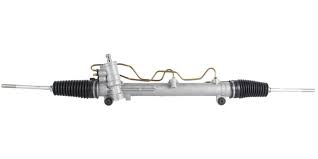Power steering is a key system in modern cars that makes driving much easier and more comfortable. It allows drivers to turn the wheels with little effort, even at low speeds. One of the most important components of this system is the power steering rack, which plays a pivotal role in transmitting the driver’s input to the steering system.
In this blog post, we’ll go over and view details about the key components of a power steering rack and how they work together to keep you on the road.
The Rack Housing
The rack housing is the outer shell of the power steering rack. It is typically made of cast iron, aluminium or steel and keeps all the internal components safe and secure. The rack housing also has holes on each end that allow the tie rods to pass through and connect to the steering knuckle. This is what allows the wheels to turn left and right.
The Pinion Gear
As the name suggests, the pinion gear is the small gear that meshes with the steering column. It is attached to the steering shaft and rotates with it. When the driver turns the steering wheel, the pinion gear rotates as well. It engages with the rack and moves it left or right, depending on the direction of the turn.
The Rack and Pinion Assembly
The rack and pinion assembly is the heart of the power steering system. It’s made up of the rack housing, pinion gear, and the rack itself. The rack is essentially a long, flat bar that has teeth on the top and bottom. It meshes with the pinion gear and moves in response to steering input. The rack and pinion assembly also has two hydraulic lines that run from the power steering pump to the power steering rack. These lines supply the necessary fluid that helps move the rack left and right.
The Hydraulic System
The hydraulic system is controlled by the power steering pump. It is responsible for supplying fluid to the power steering rack and providing the necessary force to turn the wheels. The power steering pump is driven by the engine, and its speed and pressure are regulated with a pressure control valve. When the driver turns the steering wheel, the pressure control valve opens and allows fluid to flow to the appropriate side of the power steering rack. This creates a force that helps move the wheels left or right.
The Tie Rods
The tie rods connect the rack and pinion assembly to the steering knuckle. They are responsible for transferring the power steering input to the wheels. Tie rods are typically made of steel and have adjustable ends that allow for precise alignment of the wheels. Proper alignment is important to ensure that the wheels turn in unison and that the car tracks straight.
Conclusion
In summary, the power steering rack is a complex system that requires several key components to work together. The housing, pinion gear, rack and pinion assembly, hydraulic system, and tie rods all play important roles in transmitting steering input to the wheels. Proper maintenance and regular inspections can help ensure that your power steering rack is functioning at its best, providing a smooth and comfortable driving experience.
